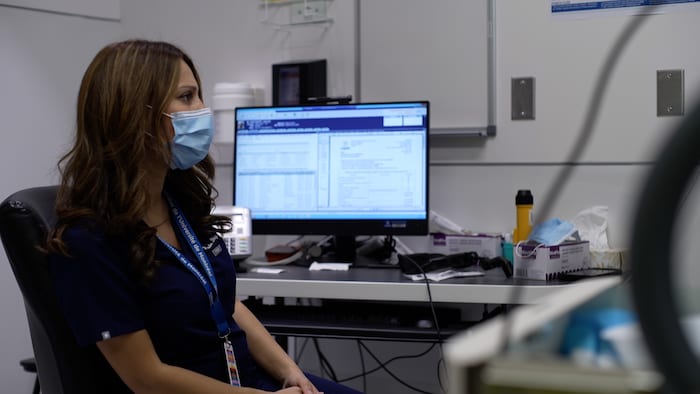Chemotherapy, radiotherapy… the journey to remission is often painful for people with cancer. What if we managed to alleviate their suffering without increasing their medication?

Open in full screen mode
Dr. Houda Bahig, oncologist at CHUM, wanted to be able to “predict patients' side effects early to intervene quickly”.
- Danny Lemieux (View profile)Danny Lemieux
Speech synthesis, based on artificial intelligence, makes it possible to generate spoken text from written text.
Improve the effectiveness of treatments , reduce their side effects, predict how the patient will react: this is what two Quebec experts hope to accomplish with the help of artificial intelligence.
Among the most disabling cancers are those of the otolaryngological (ENT) region, that is to say tumors of the nose, throat, ear, head and neck. neck, except for the brain. A nerve zone that allows you to speak, eat and breathe. So when cancer attacks these areas, it's very debilitating.
Dr. Houda Bahig, oncologist at the University of Montreal (CHUM), is well aware of the damage caused by ENT cancers.
The treatments are tough, she says. The side effects are so intense that one in three patients will need a nasogastric tube to be fed.
On its own, the first Radiotherapy treatment lasts seven weeks. The radiotherapy dose emitted is based on population studies. We are therefore far from meeting the specific needs of each patient. This is why sometimes the dose is insufficient or too high. The situation is not ideal.
To change things, Dr. Bahig enlisted Samuel Kadoury, an engineer specializing in artificial intelligence. Medical imaging no longer holds any secrets for him.
Samuel Kadoury is an engineer specializing in artificial intelligence.
We seek to anticipate complications linked to radiotherapy, to assess the probabilities of hospitalization, nasogastric tube insertion or necrosis during therapy .
A quote from Samuel Kadoury, engineer, Polytechnique Montréal
Such predictions would have incredible benefits for the treating physician and his patient.
< p class="StyledBodyHtmlParagraph-sc-48221190-4 hnvfyV">The first positive outcome is being able to predict side effects early in order to intervene quickly, emphasizes Dr. Bahig. This would make it possible to offer a less intense and more tolerable treatment.
Dr. Houda Bahig is excited by the first results of the project.
Predicting these effects early would allow treatments to be adjusted in real time throughout the process. To achieve this feat, we must create an algorithm – the brain of artificial intelligence. This task falls to Samuel Kadoury.
In his field, data is the raw material. The engineer therefore had access to the files of a thousand patients, patients treated at the CHUM over the last five to ten years.
He juggled with hundreds of files, but also with medical imaging. We are talking in particular about tomography – the famous CT-Scan which doctors use to target the area to be treated, the structures to be preserved and the dose of radiotherapy to be given.
The engineer also worked with a rather unusual visual source. Dr. Houda Bahig explains: When the patient receives their treatment, they lie on their back. Images are then taken with cone beam volume computed tomography. Essentially, they are poor quality three-dimensional images. They serve as a reference. Taken at each visit, they are used to position the patient's body as on the first day of treatment.
To refine his AI model, Samuel Kadoury notably used medical imaging.
Thanks to artificial intelligence, Samuel Kadoury managed to make these poor quality and very little used images speak. By combining this discovery with other medical data, he was able to predict the effect of radiotherapy treatments. Much to the pleasure of Dr. Bahig.
For now, it& #x27;is very, very encouraging. We are able to predict early which patient will need a nasogastric tube, which patient will need to be hospitalized and even which patient will need to receive opiates.
A quote from Dr. Houda Bahig, oncologist, University of Montreal Hospital Center
The accuracy of their AI tool is slightly higher than what studies constructed from huge cohorts of patients conclude.
We still had accuracy rates above 75% based solely on data, imaging tests and information available in the patient's file, says Samuel Kadoury, not without pride. /p> A report by Danny Lemieux and Sylvain Caron on the use of artificial intelligence to predict the effects of cancer treatments will be featured on the showDécouverte broadcast Sunday at 6 h 30 on HERE TV and at 10 h on ICI Explora, and Saturday at 7h 30 on ICI RDI. Their model was tested on 1,100 people. This is still too little to confirm its effectiveness. More patients will therefore be needed and they will need to represent different groups. For example, for people from remote areas, First Nations people, we don't have a lot of information or images related to this group, mentions Samuel Kadoury. So, ideally, [we will have] a truly global representation of the population which will allow us to have trained systems without having bias. In a few months, their algorithm will take a new step. We are going to test it not with former patients, but with patients undergoing treatment. We will be able to evaluate the images, make predictions, try to intervene and see if this tool can actually help us reduce side effects and improve the quality of life of patients, explains the oncologist. We will have two cohorts of patients, continues Samuel Kadoury. The first group will have normal care and the second will be monitored with our artificial intelligence tool. We will then compare the two cohorts to see if the use of AI had beneficial effects.
Samuel Kadoury and Dr. Houda Bahig intend to soon test the AI tool with patients in treatment course.
With patients fearing that artificial intelligence will replace the oncologist, Dr. Bahig wants to be reassuring: Someone will always have to make sure that the algorithm has done its job well. "Does that make sense?" We will always need to have an expert eye.
According to her, artificial intelligence will even give more power to its patients. For example, if AI predicts that a person has a 50% chance of being hospitalized due to complications, what will we do? This decision must be made by two people.
If we are able to tell a patient with more precision "here are the risks". He will be able to make a decision in line with what he wants, with his values, says Dr. Bahig.
- Danny Lemieux (View profile)Danny LemieuxFollow

